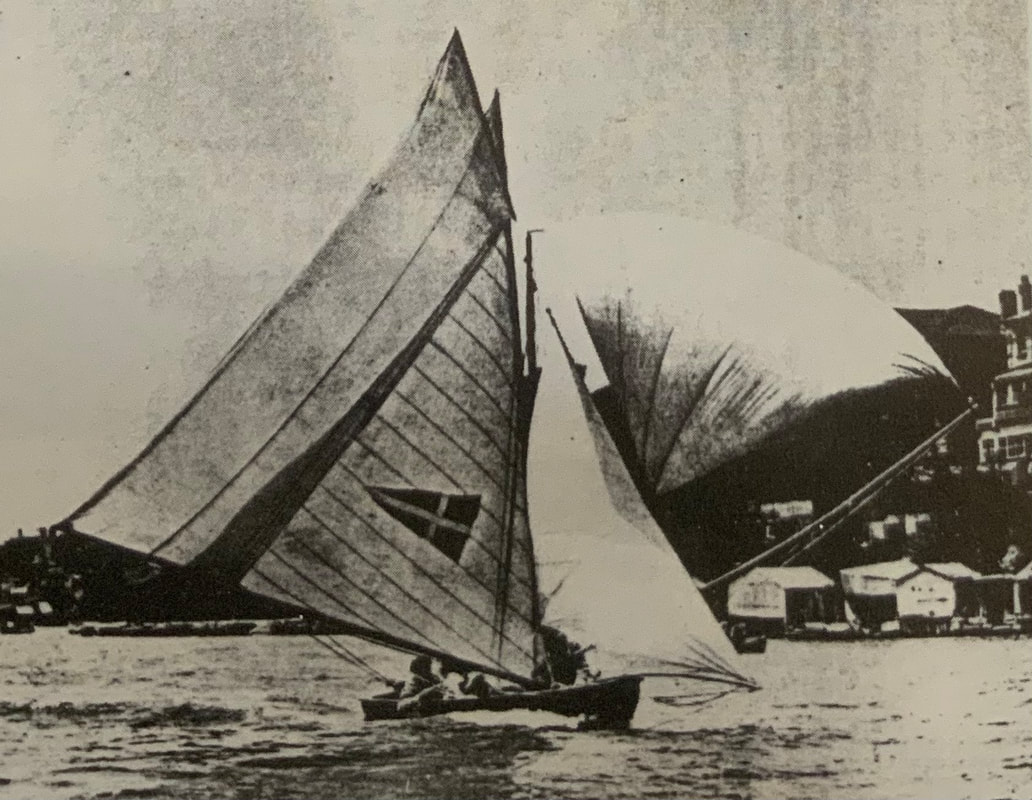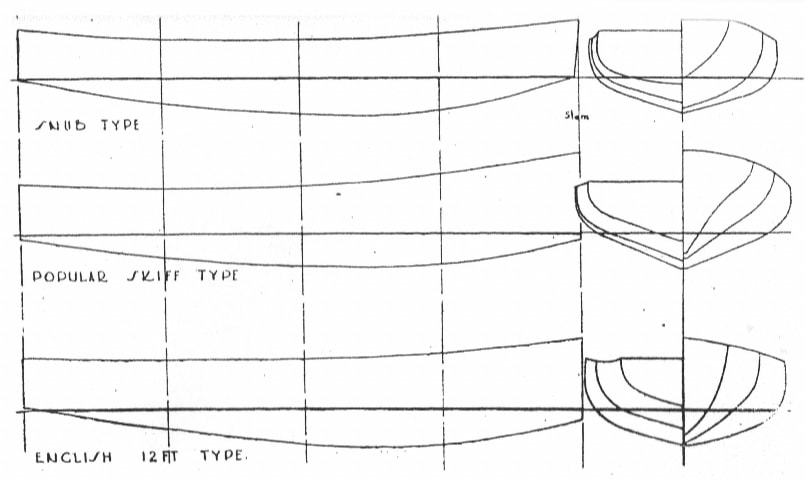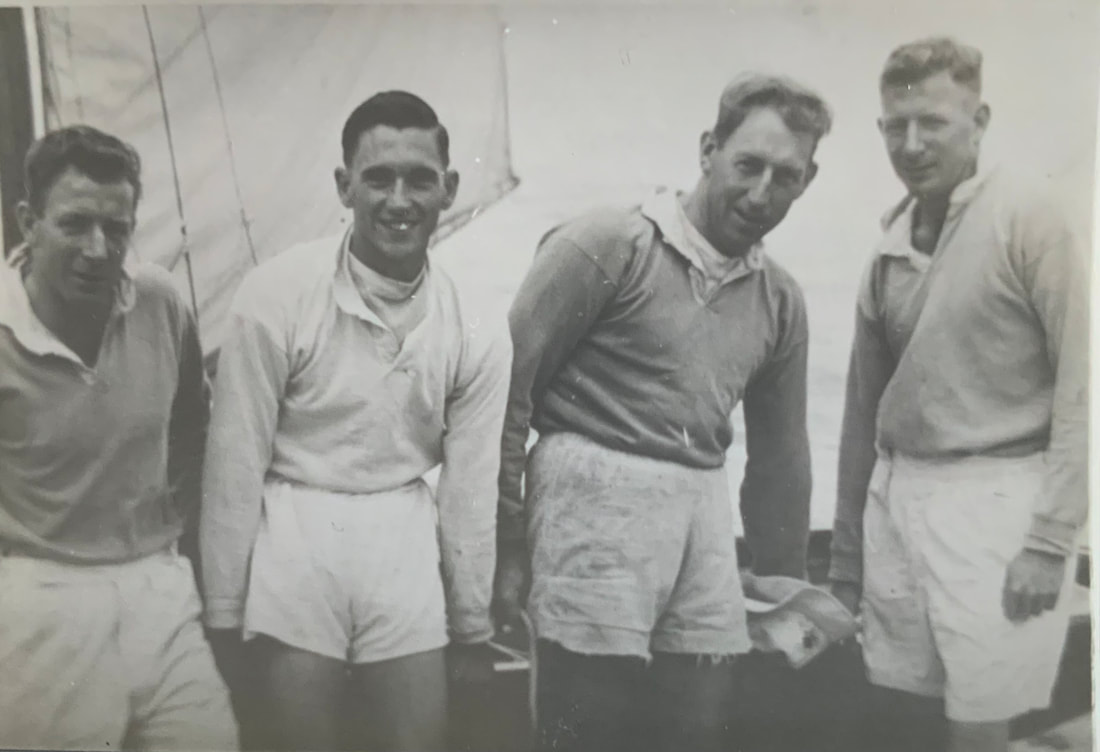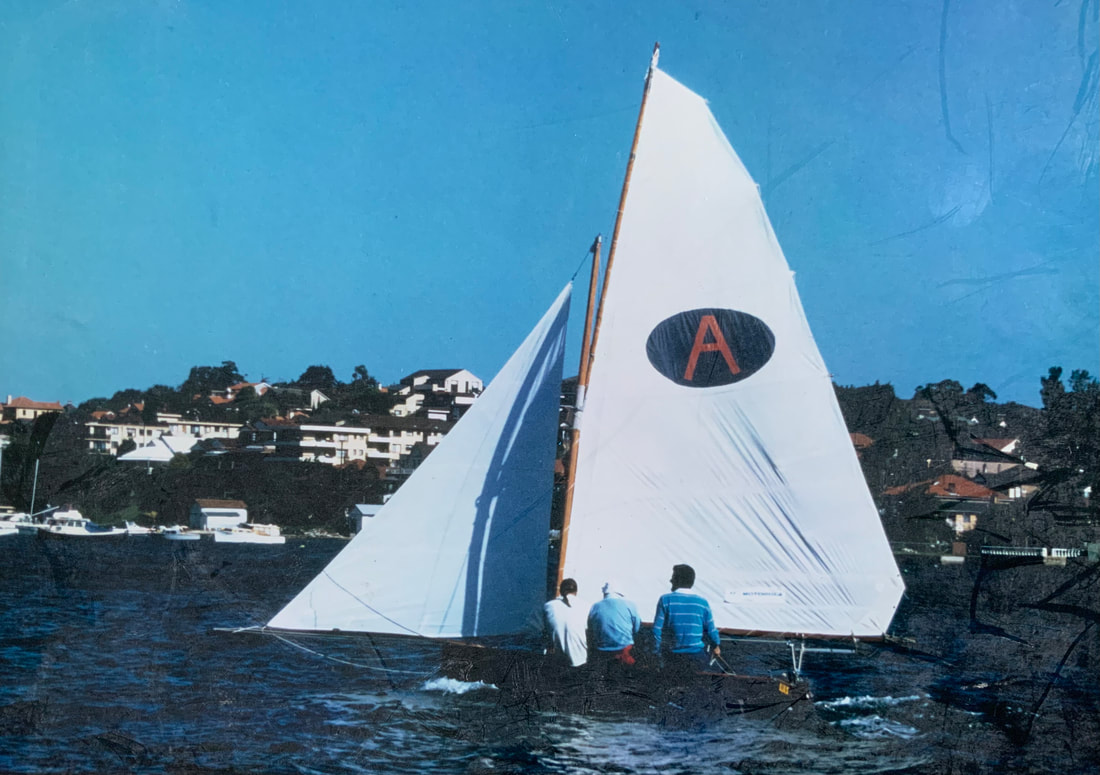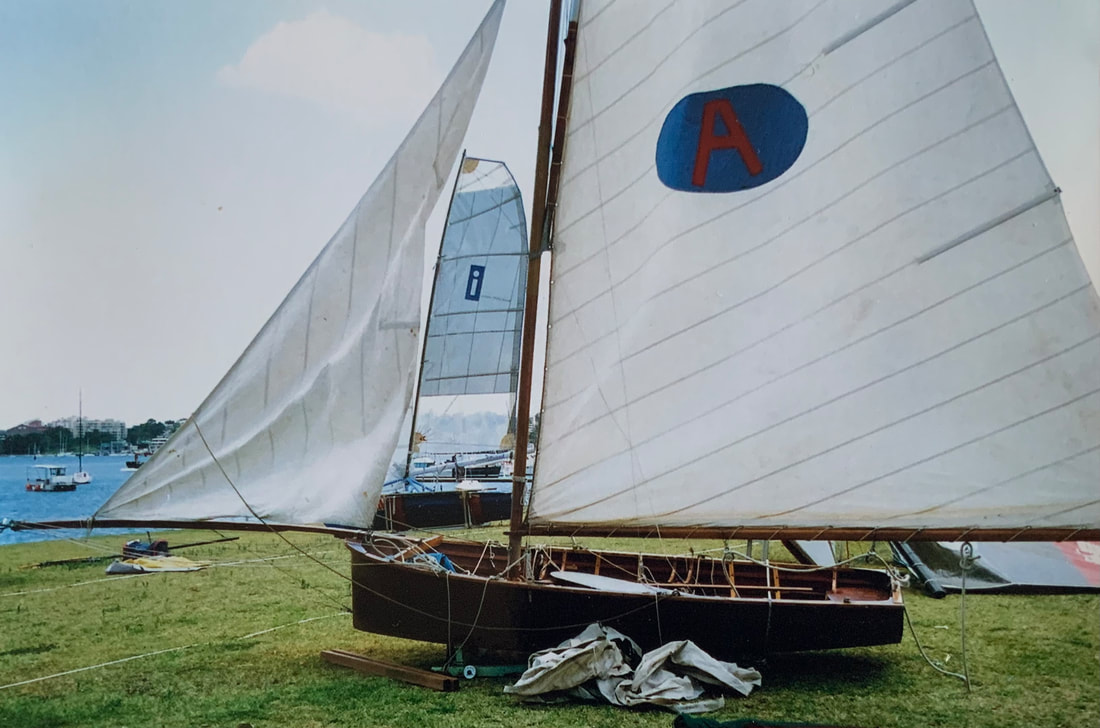We haven’t paid much attention to the 12-foot skiffs, but we’ll soon fix that. They started a bit later than the other classes but grew to be possibly the most numerous skiff class in the late 1940's. Here’s a bit about their early days.
The 12- foot skiffs carried more sail relative to their hull length than any of the bigger classes (and still do in the 21st century). They also emulated the sixteens in hull construction and internal layouts, including I believe eliminating the built heel in the 1920’s. Beam was restricted to five feet and decks were prohibited. They became quite a large class, putting a hundred boats on the water in 1948 plus 50 more in the restricted sail area class, and have survived (and evolved) as a class to the present day.
Early history of the 12- foot skiffs is hard to find. According to the website of the Lane Cove 12ft Sailing Skiff Club, the original Lane Cove Amateur Sailing Club took on 12’ skiffs as its main racing class in 1918, and an article in Seacraft magazine in January 1948 probably written by Bryce Mortlock says it was 1917 and the idea of the Club secretary Ben Roff. An article by JF Black in the Australian Aquatic Annual in 1937 supports the 1917 date, the same year that a short-lived Cremorne Sailing Club which had introduced a restricted sail area 12 foot skiff three years earlier was wound up. Prior to the War the Lane Cove Club had been sailing mainly 10’ and 6’ dinghies. In January 1920 the Anniversary Regatta held a race for 12’ skiffs “under the rules of the Lane Cove Sailing Club”.
The 12- foot skiffs carried more sail relative to their hull length than any of the bigger classes (and still do in the 21st century). They also emulated the sixteens in hull construction and internal layouts, including I believe eliminating the built heel in the 1920’s. Beam was restricted to five feet and decks were prohibited. They became quite a large class, putting a hundred boats on the water in 1948 plus 50 more in the restricted sail area class, and have survived (and evolved) as a class to the present day.
Early history of the 12- foot skiffs is hard to find. According to the website of the Lane Cove 12ft Sailing Skiff Club, the original Lane Cove Amateur Sailing Club took on 12’ skiffs as its main racing class in 1918, and an article in Seacraft magazine in January 1948 probably written by Bryce Mortlock says it was 1917 and the idea of the Club secretary Ben Roff. An article by JF Black in the Australian Aquatic Annual in 1937 supports the 1917 date, the same year that a short-lived Cremorne Sailing Club which had introduced a restricted sail area 12 foot skiff three years earlier was wound up. Prior to the War the Lane Cove Club had been sailing mainly 10’ and 6’ dinghies. In January 1920 the Anniversary Regatta held a race for 12’ skiffs “under the rules of the Lane Cove Sailing Club”.
Schemer (1924) was the second Australian Champion 12-ft skiff and was a snub 12-footer of 4’6” beam, built by Wee Georgie Robinson and steered with great success by Ben Roff. From the Greenwich Flying Squadron 75-year book.
By 1924 the Club had 20 boats, 13 in private sheds and 7 in one large shed at the SE end of Bay St Park, Greenwich. The boats had 4 crew, and their sail area was restricted to 120 sq ft jib and main, and 90 sq ft of spinnaker. Ben Roff and others at the Club wanted to change to unrestricted sail area, and the Club split in February 1924, the unrestricted supporters setting up a new club, Greenwich Flying Squadron with 6 boats, which grew to 17 boats by the second season.
In 1925 Ben Roff wrote to Fred Smith and the Brisbane 12-foot Junior Sharpie Club suggested an interstate competition for unrestricted 12-foot skiffs. The Junior Club declined as their boats did not fit the Greenwich hull rules (5’ beam, 20” deep and round-bilged), but Alf Whereat of the local boatbuilding family (and incidentally the designer/builder of the 18’ Aberdare later on) accepted the challenge and began to build a boat he name Defiance. Queenslanders set up the Bulimba 12-ft skiff Flying Squadron to host the event, but soon changed its name to the Brisbane 12-ft Skiff Flying Squadron. Ben Roff’s boat Schemer (built by Wee Georgie Robinson and Champion of the Greenwich Flying Squadron for 3 seasons in a row) arrived in Brisbane by steamer in March 1926 for a scheduled 3-heat Championship (unusual at the time when most Championships were decided on one race). Alf Whereat in Defiance won both of the first 2 heats on the Hamilton reach and no third heat was necessary. A second Queensland boat had been built in time to enter the second race, and two more were built for the following season.
In 1925 Ben Roff wrote to Fred Smith and the Brisbane 12-foot Junior Sharpie Club suggested an interstate competition for unrestricted 12-foot skiffs. The Junior Club declined as their boats did not fit the Greenwich hull rules (5’ beam, 20” deep and round-bilged), but Alf Whereat of the local boatbuilding family (and incidentally the designer/builder of the 18’ Aberdare later on) accepted the challenge and began to build a boat he name Defiance. Queenslanders set up the Bulimba 12-ft skiff Flying Squadron to host the event, but soon changed its name to the Brisbane 12-ft Skiff Flying Squadron. Ben Roff’s boat Schemer (built by Wee Georgie Robinson and Champion of the Greenwich Flying Squadron for 3 seasons in a row) arrived in Brisbane by steamer in March 1926 for a scheduled 3-heat Championship (unusual at the time when most Championships were decided on one race). Alf Whereat in Defiance won both of the first 2 heats on the Hamilton reach and no third heat was necessary. A second Queensland boat had been built in time to enter the second race, and two more were built for the following season.
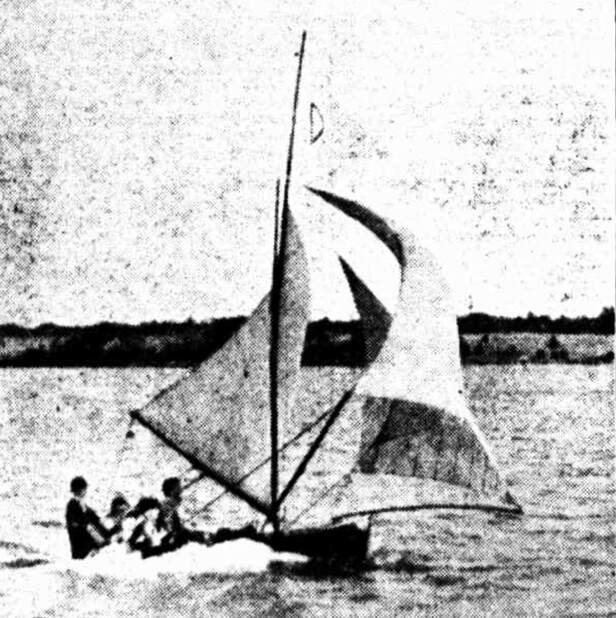
Cecilia the leading Brisbane 12-ft skiff, beaten by Schemer in Sydney in 1926/27.
Brisbane sent 3 boats to Sydney for the 1926/27 Championships held between Christmas and New Year. The boats were Zara, Zana and Cecilia. Cecilia had won 4 of the 6 races held prior to coming to Sydney and was 2nd in the other two, and both Zara and Zana had consistently beaten Defiance, who consequently did not travel to Sydney. But all three Queensland boats were decisively beaten by the Greenwich fleet, not gaining a place in any race. Schemer won 2 heats and capsized in the other but took the title.
This established the pattern of alternate season Championships in Sydney and Brisbane, and we’ll have more stories of these contests in the future.
This established the pattern of alternate season Championships in Sydney and Brisbane, and we’ll have more stories of these contests in the future.
Seacraft magazine in 1948 had these sketches by Bryce Mortlock of the types of 12-footers then being built. From The Open Boat book. Like the 16-ft skiffs the 12’s lost the heel in the 1920’s, but hull shapes and rigs did not change significantly until the late 1950’s.
Here's the story of the 12-foot skiff AJAX (1951)
Ajax was built and sailed by Don and Les Barnett, and later sold to Peter Notley. This shot is from John Notley’s collection.
Ajax was built by Don and Les Barnett in 1951 to replace their earlier boat Respond. The boat was successful from the start. Don steered and Les and others including N Taylor, W Budnick, J Allen and J Hardie crewed. They were State Champions in 1951/52 and 1952/53, and Australian Champions in 1952/53.
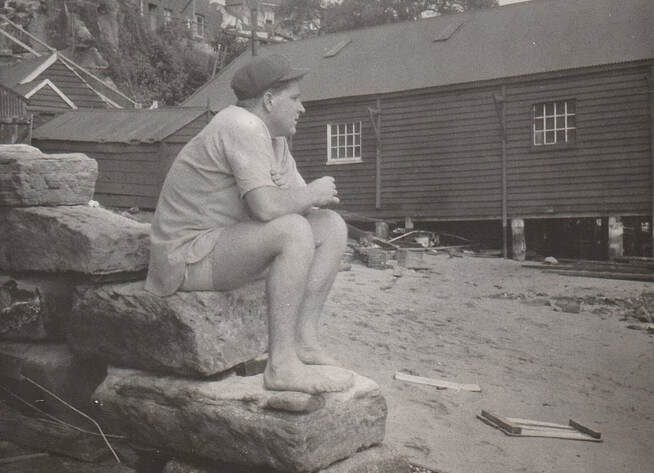
A pensive Don Barnett near the old SCEGGS rowing shed in Berrys Bay. Photo Phil Barnett.
Peter Notley bought the boat off them in 1954 and continued the success, 2nd in the State Championship in 1954/55, won the State Championship in 1955/56 and were 2nd in the Australian Championship, won the State Championship again in 1957/58 and lost the Australian Championship on protest that year. Peter Notley sailed Ajax until 1959 with his brothers Dick and John as crew, plus Bobby Sawyer, R Winn, K Robinson and G Wood.

Ajax hard pressed. Photo Phil Barnett.
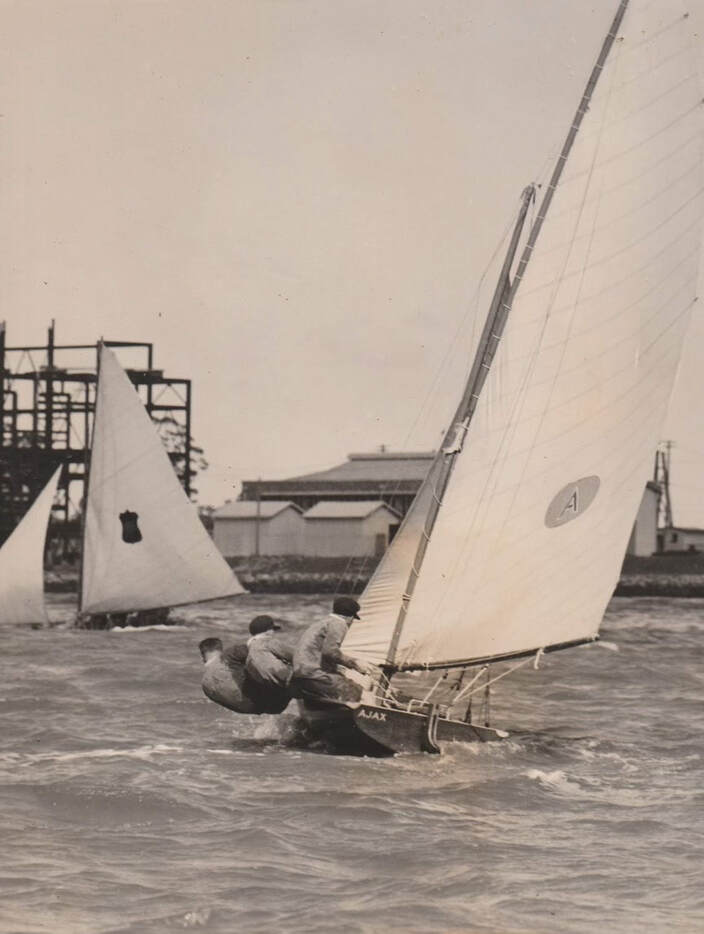
Ajax working up the Parramatta River. Photo Phil Barnett.
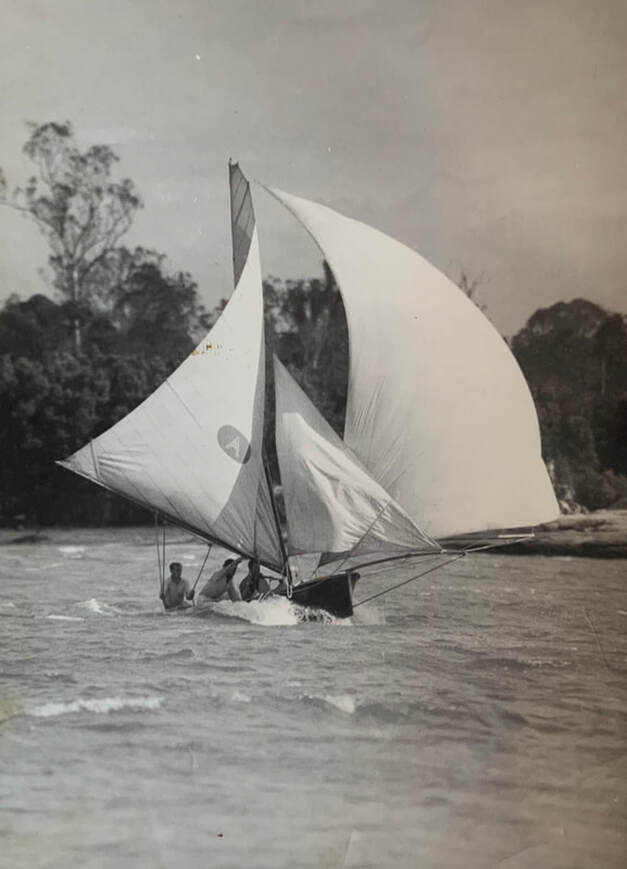
Ajax downwind with the Notley brothers. Photo John Notley.
Below: L-R Dick Notley, G Wood, John Notley, Peter Notley. Photo John Notley.
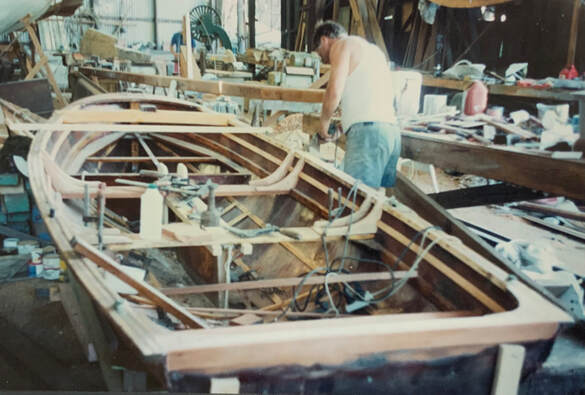
Ajax remained at the Greenwich Club for many years as a sort of training boat. In 1960 J Scope replaced the ageing batten seam carvel planking with 2 skins of diagonal planking, and fitted a Bermudan rig. In 1992 John Notley restored the hull and took the rig back to gaff using the original spars and sails. With the formation of the Australian Historical Sailing Skiff Association, John began sailing Ajax at invitation events at various clubs along with the first AHSSA 10-footers.
The boat has not sailed for some seasons now, but is still kept in John Notley’s garage. He expects to soon hand it over to Phil Barnett.
Left: In 1992 John Notley organised for Ajax to be restored, with most of the work done by AHSSA founder Robert Tearne. Photo John Notley.
The boat has not sailed for some seasons now, but is still kept in John Notley’s garage. He expects to soon hand it over to Phil Barnett.
Left: In 1992 John Notley organised for Ajax to be restored, with most of the work done by AHSSA founder Robert Tearne. Photo John Notley.
Below: The restored Ajax sailing in the early 1990’s. Photo John Notley.
Ajax at Drummoyne Sailing Club for one of the AHSSA's events in the early 1990's. Photo John Notley.
